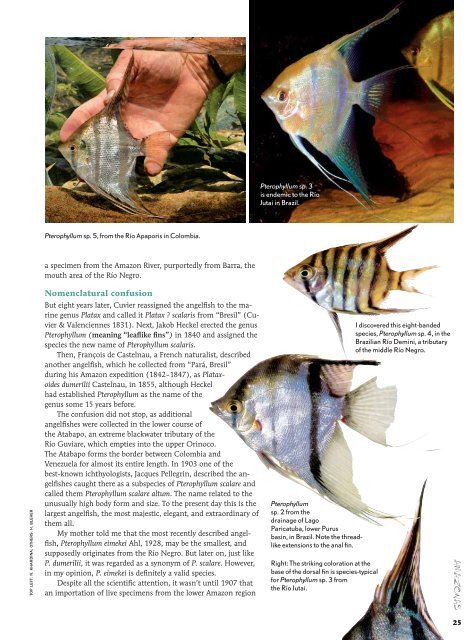Angels - PageSuite
Angels - PageSuite
Angels - PageSuite
You also want an ePaper? Increase the reach of your titles
YUMPU automatically turns print PDFs into web optimized ePapers that Google loves.
TOP LEFT: N. KHARDINA; OTHERS: H. BLEHER<br />
Pterophyllum sp. 5, from the Río Apaporis in Colombia.<br />
a specimen from the Amazon River, purportedly from Barra, the<br />
mouth area of the Río Negro.<br />
Nomenclatural confusion<br />
But eight years later, Cuvier reassigned the angelfish to the marine<br />
genus Platax and called it Platax ? scalaris from “Bresil” (Cuvier<br />
& Valenciennes 1831). Next, Jakob Heckel erected the genus<br />
Pterophyllum (meaning “leaflike fins”) in 1840 and assigned the<br />
species the new name of Pterophyllum scalaris.<br />
Then, François de Castelnau, a French naturalist, described<br />
another angelfish, which he collected from “Pará, Bresil”<br />
during his Amazon expedition (1842–1847), as Plataxoides<br />
dumerilii Castelnau, in 1855, although Heckel<br />
had established Pterophyllum as the name of the<br />
genus some 15 years before.<br />
The confusion did not stop, as additional<br />
angelfishes were collected in the lower course of<br />
the Atabapo, an extreme blackwater tributary of the<br />
Río Guviare, which empties into the upper Orinoco.<br />
The Atabapo forms the border between Colombia and<br />
Venezuela for almost its entire length. In 1903 one of the<br />
best-known ichthyologists, Jacques Pellegrin, described the angelfishes<br />
caught there as a subspecies of Pterophyllum scalare and<br />
called them Pterophyllum scalare altum. The name related to the<br />
unusually high body form and size. To the present day this is the<br />
largest angelfish, the most majestic, elegant, and extraordinary of<br />
them all.<br />
My mother told me that the most recently described angelfish,<br />
Pterophyllum eimekei Ahl, 1928, may be the smallest, and<br />
supposedly originates from the Río Negro. But later on, just like<br />
P. dumerilii, it was regarded as a synonym of P. scalare. However,<br />
in my opinion, P. eimekei is definitely a valid species.<br />
Despite all the scientific attention, it wasn’t until 1907 that<br />
an importation of live specimens from the lower Amazon region<br />
Pterophyllum sp. 3<br />
is endemic to the Río<br />
Jutai in Brazil.<br />
Pterophyllum<br />
sp. 2 from the<br />
drainage of Lago<br />
Paricatuba, lower Purus<br />
basin, in Brazil. Note the threadlike<br />
extensions to the anal fin.<br />
Right: The striking coloration at the<br />
base of the dorsal fin is species-typical<br />
for Pterophyllum sp. 3 from<br />
the Río Jutai.<br />
I discovered this eight-banded<br />
species, Pterophyllum sp. 4, in the<br />
Brazilian Río Demini, a tributary<br />
of the middle Río Negro.<br />
AMAZONAS 25<br />
25




